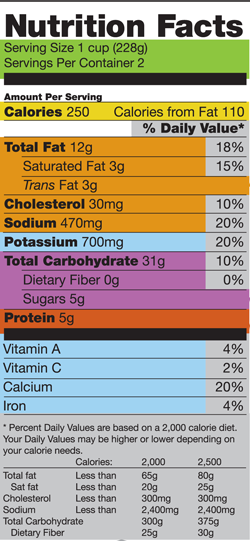Next Generation Nutrition Facts Label: What to Add or Ax?
 A recent Washington Post op-ed, FDA Should Revamp Nutrition Labels, by Michael Jacobson, PhD, and executive director of the Center for Science in the Public Interest, got me thinking about what I would add or ax from the next generation Nutrition Facts label. Yes, rumor has it we may eventually see a next generation Nutrition Facts label. Jacobson’s op-ed indicated sometime in 2013 as did a well written HuffPost Food blog, but I’m not holding my breath!
A recent Washington Post op-ed, FDA Should Revamp Nutrition Labels, by Michael Jacobson, PhD, and executive director of the Center for Science in the Public Interest, got me thinking about what I would add or ax from the next generation Nutrition Facts label. Yes, rumor has it we may eventually see a next generation Nutrition Facts label. Jacobson’s op-ed indicated sometime in 2013 as did a well written HuffPost Food blog, but I’m not holding my breath!
It does looks like we will soon, (ah, a relative term when speaking about government regulations), see more Nutrition Facts for standard menu items in restaurants and retail food establishments, thanks due to the Affordable Care Act (aka Obamacare). Any additional Nutrition Facts are welcomed!
Our current Nutrition Facts label came into being due to the 1990 Nutrition Labeling and Education Act and began appearing on packaged foods around 1994.
Complete Guide to Carb Counting

- baffled by which foods contain carbohydrate and how much?
- confused about how much carbohydrate YOU need to eat each day?
- overwhelmed in the supermarket aisles reading food and nutrition labels?
- inept at where to find carb counts for your favorite foods?
The Complete Guide to Carb Counting, is the American Diabetes Association’s A-Z guide to carbohydrate counting. Carb Counting has quickly become the most popular method of meal planning for diabetes. That’s because research shows it meshes well with real life and the medications available today to manage diabetes. The book begins with answers to two key questions: what is carbohydrate and why should you carb count? Next you'll build your knowledge base about how to count carbs, how much carb to eat, how to use food labels, count carbs in restaurant foods, and much more. This book is right for you if you have type 2 diabetes and use carbohydrate counting to plan choose your foods and plan your meals. The book also has all the details you need if you use carbohydrate counting to determine your meal time insulin doses. Lastly you’ll decipher how to fine-tune your blood glucose levels by observing your blood glucose patterns (aka pattern management).
Reviews
Table of Contents
- What Is Carb Counting?
- Basic Carb Counting
- Keeping Track
- Protein, Fat and Alcohol Count, Too
- Weigh and Measure Foods—A Key to Your Success
- The Food Label Has the Facts
- Carb Counting in Real Life
How to Count Convenience Foods and Recipes - Carb Counting in Real Life
How to Count Restaurant Meals and Take Out Foods - Blood Glucose Pattern Management: Fine-Tune Your Control
- Blood Glucose-Lowering Medications and Insulin
- Advanced Carb Counting
- Cornerstones—Knowledge and Support
- Appendixes
- Carb Counts of Everyday Foods
- Carb Counting Resources
- Record Keeping Forms
When it Comes to Restaurants’ Nutrition Facts, Buyer Beware?
A recent report from a Scripps Television station investigation reveals wide discrepancies between the restaurant’s nutrition facts (calories and fat) and those determined by laboratory nutrition analysis. The investigation took place over 3 months, in 8 cities and on meals mainly from sit down restaurants, such as Chili’s, Applebee’s, and Cheesecake Factory ; and one fast food restaurant, Taco Bell. Some discrepancies were several fold, even on healthier entries. Others were more on target.


